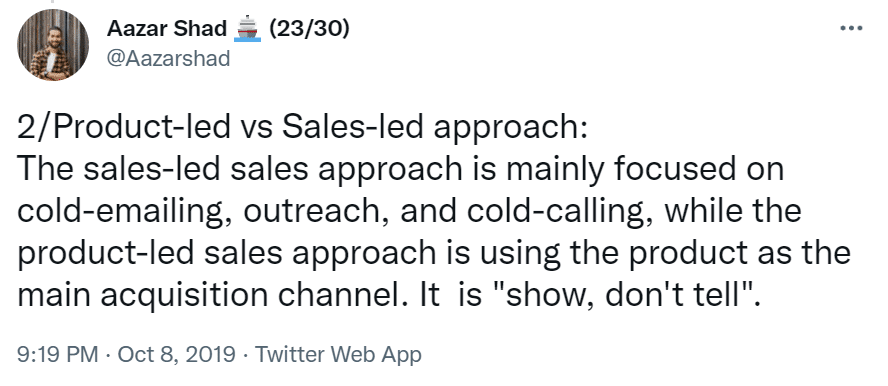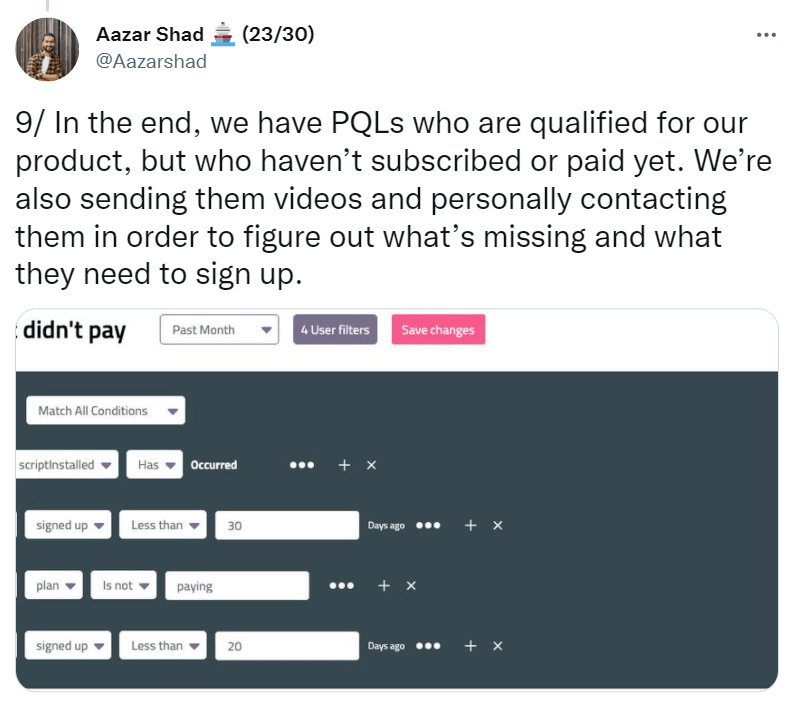Should you choose product-led as your go-to-market strategy now that it’s in full swing?
In this product-led vs sales-led guide, let’s dig deep into the fundamental differences of both approaches and why PLG doesn’t always work.
Product-Led vs Sales-Led: 4 Key Differences
Difference #1. Point of Contact
Product-led growth is a “free trial or freemium done right” strategy that uses the product as the main channel for customer acquisition, conversion, retention, and expansion.

In product-led, everything is self-service.
Customers sign up for a free trial, upgrade to a premium plan, and cancel their subscription without communicating with sales instantly.
On the other hand, the sales-led approach involves the prospect interacting with a sales rep (or customer success rep and the like) at every stage of the buying journey.
Even though 43% of B2B customers prefer a sales rep-free experience, make no mistake: product-led isn’t the winner here.
As you’ll learn more in this post, the PLG movement doesn’t work for every company.
TL;DR on product-led vs sales-led difference #1: The point of contact for product-led is the product. For sales-led, it’s the sales development representative, account executive, and customer success manager.
Difference #2. Buying Cycle
The product-led strategy boasts a shorter sales cycle, thanks to the low barrier to entry and its main clientele: SMBs.
All these SMB customers need to do is register an account, explore the product, and input their credit card information when they’re ready to upgrade. If the product is a perfect fit, all this can happen within a few hours.
Unlike product-led, sales-led typically focuses on enterprises. Long buying cycles come with the package.
SDRs selling to giant corporations often need to deal with qualification meetings, demos, nerve-racking customer objections, negotiation, and an avalanche of complex requirements.
Once again, there’s no clear winner here. While product-led takes a shorter time to close, its sales deals (and customer lifetime value) are much smaller than sales-led.
TL;DR on product-led vs sales-led difference #2: Product-led focuses on SMBs (short sales cycle), whereas sales-led targets enterprises (long sales cycle).
Difference #3: Cost Efficiency
One of the best things about going product-led is the built-in cost efficiency.
Unlike sales-led, product-led involves almost zero outbound sales efforts…at least in the beginning.
Now that the product is the primary driver of acquisition, conversion, retention, and expansion, you can get by with a modest team.
Look at Ahrefs.
The SEO software company has over $50M in annual recurring revenue and 3,200+ new leads every week despite having zero salespeople on their team.
But it’s a different story with sales-led, as you’d need to invest in recruitment, training, and assets (e.g., scripts, sales battle cards).
TL;DR on product-led vs sales-led difference #3: Product-led doesn’t require a huge sales team like sales-led.
Difference #4: Control
At first glance, it may seem like product-led is the reigning champ (“you got me at cost efficiency”), but as you know by now, it’s a lot more complicated than it looks.
One downside to PLG is the lack of control.
Since everything is self-served, you can’t fully control how potential customers interact with your product.
According to Wyzowl, 8 in 10 users deleted an app because they didn’t know how to use it.
This leads us to wonder, is it possible to prevent these users from leaving if we had intervened at the right time?
Here at Breadcrumbs, we think so. In fact, it’s one of those light-bulb moments that inspired us to build our lead scoring tool. In lead scoring, you rate your leads according to their sales-readiness. The higher the score, the more ready they are to buy your product. To get started: - Connect your CRM and product analytics tool with Breadcrumbs - Enter your criteria on what makes an at-risk user or customer (e.g., doesn't login in three days, visits support center on canceling account) - Activate your scoring model Now you can view your users’ analytics at the activity level and step in at the right time. Book a 30-minute demo with Breadcrumbs to catch users before they churn today. Bonus tip: Use in-app onboarding to help your freemium and trial users understand how to use your product. For example, you could try displaying personalized content within the product to guide users based on their functional role or actions.

Control-wise, this is where sales-led proves superior. Since the buyer interacts with the salesperson one-on-one, you have greater control over their buying journey.
The demo presents a valuable opportunity to identify the prospect’s pain, qualify if it’s a good fit for their use case, and personalize the presentation accordingly.
TL;DR on product-led vs sales-led difference #4: Because of its self-served nature, product-led doesn’t give you complete control of how users experience your product. However, sales-led allows you to personalize prospects' experience from the get-go.
Product-Led vs Sales-Led: Who’s the Winner?
Should you pick product-led?
If your product hasn’t achieved product/market fit or it’s highly complicated, avoid product-led for the time being.
That’s the situation we found ourselves in a few months ago.
A case study ft. Breadcrumbs When we offered a freemium plan, we discovered that our new product wasn’t mature enough to support all use cases. Eventually, we narrowed our focus on our mid-market clients and change to a sales-assisted route. We plan to use the insights from our first go-to-market strategy iteration to inform our next product-led growth strategy on the long road ahead. As Gary Amaral, CMO of Breadcrumbs, has shared previously, “We may not support SMBs yet, but we are moving in this direction as the product matures.”
Note that product-led companies—especially those that mature and enter enterprise sales—will implement sales-led at some point.
UserPilot, a product growth platform, personally reaches out to its product-qualified leads (PQLs) to figure out what’s holding them back from upgrading.

A PQL is a lead who has experienced the value of your product in a freemium or free trial. Be sure to prioritize this value metric in your product-led strategy and implement it across your company.
To identify PQLs on Breadcrumbs, complete the following steps: 1. Connect your product analytics tool with Breadcrumbs 2. Set the attributes that make a PQL (e.g., invites a user, logins every day) Note that PQLs are still a siloed subset of data. To take a holistic view of all lead activity and turn your product into a large sales force in PLG, connect your CRM with Breadcrumbs and determine what makes a sales-qualified lead (SQL). With product usage and engagement data housed in one platform, you can connect the dots with your lead’s behavior, identify what’s holding them back, and convert them to customers quickly. Book a 30-minute demo with Breadcrumbs today.

Product-Led vs Sales-Led: There’s no Clear-Cut Winner
Both product-led and sales-led play essential roles in revenue acceleration.
It’s impossible to say which approach is the best as a go-to-market strategy, as it depends heavily on your product, target audience, and business model.
Over to you.
Product-led vs sales-led: Which do you think will perform best for your business?
Unlike other lead scoring tools out there, Breadcrumbs prioritizes your leads and engages with your existing customers when they’re ready to buy, upsell/cross-sell or churn—in one platform. Book a 30-minute demo with Breadcrumbs today.



